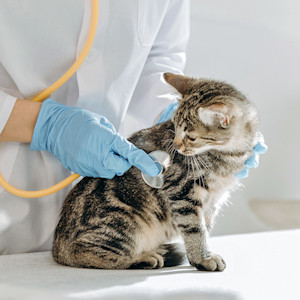A Guide to Worms in Cats: Learn the Signs and Treatment Options
How to detect and treat worms to keep your cat healthy.

Share Article
In This Article:
Common Types of Worms In Cats What Are the Signs And Symptoms of Worm Infestation? How Are Worms Diagnosed In Cats? Treatment Options For Worms How to Prevent Worms In Cats Do You Need to Clean Your House If Your Cat Has Worms? Can I Touch My Cat If They Have Worms?
Many cats begin their lives infected with worms. Kittens often get worms from their mother’s milk, contaminated feces, or soil if allowed contact with it. Adult cats can readily become infected if allowed outdoors. Worms are not just aesthetically offensive to people but also harmful to your cat’s health. These parasites can make your cat uncomfortable and cause serious health issues if left untreated. Cat parents must be aware of worms, the various types, how to check for them, how to get rid of them, and prevention.
Common types of worms in cats
There are various types of worms cats can be infected with, including the following.
Roundworms
Roundworms live in the intestines of your cat. They are the most common intestinal parasite in cats. Kittens are particularly susceptible and often contract them from their mother’s milk or contact with contaminated feces. Roundworms can grow several inches long and consume partially digested food in the intestines. Symptoms include a potbellied appearance to the abdomen, weight loss, and the presence of live worms in your cat’s poop or vomit.

It is very important to point out that humans, especially children, can contract roundworms by coming into contact with contaminated soil or feces. This makes prompt treatment essential not only for your cat's health but also for your family's health.
Hookworms
Hookworms are smaller than roundworms but dangerous because they can attach to your cat’s intestinal lining. Once there, they feed on blood, which can lead to anemia. In addition to attaching to the intestines, they can penetrate the skin. Symptoms include weakness, bloody stools, and pale gums.
Hookworms are especially dangerous to elderly cats and kittens because they can cause significant blood loss. A hookworm infection can even be fatal.
Tapeworms
Cats get tapeworms from eating infected fleas or rodents. Tapeworms are long, segmented worms that also attach to the small intestine. Cat parents may see small segments that look like grains of rice around their anus or in their poop. They cause milder symptoms than other worms but can lead to digestive discomfort and weight loss. The best way to prevent them is to keep your cat from getting fleas.
Whipworms
Whipworms are less common than the other worms. They live in the large intestines and cause inflammation and irritation, leading to chronic diarrhea, weight loss, and general poor health. Whipworms are rare but difficult to kill. It may take several rounds of treatment to eradicate them.
What are the signs and symptoms of worm infestation?
Symptoms vary depending on the type of worm, but in all cases, early detection and treatment lead to the best results. Therefore, it’s important to know the symptoms.
Digestive issues
Vomiting, diarrhea, and bloating are typical symptoms of a worm infestation. You may also notice weight loss, despite an increased appetite. You may see a change in your cat’s stool consistency or color. Blood or mucus may become apparent and indicate a need to see the vet immediately. Even without blood or mucus, postponing treatment can lead to malnutrition and a weakened immune system.
Respiratory issues
Some worms can cause lung issues, even pneumonia, because the worms migrate to the lungs. Roundworms are an example. You will see coughing, wheezing, or trouble breathing. Your cat may be lethargic or reluctant to engage in activity.
Skin irritations
Hookworms are one of the few worms that can penetrate the skin. You may see itching, redness, and irritation. Secondary infections may occur from excessive scratching. It can be difficult to diagnose skin hookworms because the skin will look like many other skin conditions. A thorough veterinary examination is essential for accurate diagnosis.
Systemic illness:
Liver flukes can be contracted by ingesting snails, lizards, frogs. Symptoms include lethargy, fever, enlarged liver, jaundice (yellowing of the skin and eyes), as well as poor appetite, vomiting, and diarrhea. These patients may remain normal for many years before symptoms develop, and is most common in cats who have, or have had, access to the outdoors.
Heartworms are transmitted by mosquitos and is life-threatening for cats. There is no approved treatment for this condition, so prevention is the only means of protecting cats from heartworm. Speak to your vet about prevention methods.
Behavioral changes
Cats with worms may show a change in behavior, such as:
lethargy
irritability
decreased interest in play and social interaction
signs of pain or discomfort
changes in grooming habits
increased vocalization
Respiratory signs with heartworms
If your cat shows signs of pain or discomfort, the infection is probably severe and needs immediate vet attention.
How are worms diagnosed in cats?
A proper diagnosis is essential for effective treatment. Veterinarians use several methods to identify worm infestations:
Vet exams
A physical examination may reveal visible worms around the anus or a potbellied appearance. Pale gums or weight loss can also indicate anemia (a lack of circulating blood) or malnutrition.
Fecal tests
Fecal analysis is one of the most reliable methods for detecting worms. When you take your cat to the vet, try to take a sample from the litter box so the vet can analyze it under a microscope. They will be looking for worm eggs or larvae. If your cat goes outdoors or shares a litter box with a cat that does, it is recommended the stool be tested every six months.
Blood tests
In some cases, blood tests may be necessary to diagnose certain types of worms, such as heartworms. Many people think only dogs get heartworm, but cats can get heartworm, too. It is very important that cats take preventative medication for heartworm because if they get the disease, there is no cure.
Treatment options for worms
Once diagnosed, promptly treating worms is crucial to your cat’s health. Treatment options include:
Prescription medications
The most common way for worms to be treated is with medication your vet will prescribe for your cat. It will be specific for the type of worm you are trying to eradicate. These medications are very effective and safe. Some are given by injection, and others require you to give pills or oral liquid.
Over-the-counter solutions
While some over-the-counter dewormers are available, they may not be as effective or safe as prescription options. Consult your vet before using any over-the-counter treatments, as incorrect dosages or formulations can harm your cat.
Natural remedies
Natural remedies are sometimes used as supplementary treatments. However, it is unclear if they really work, so they should not replace visiting your vet. Always consult your vet before trying natural remedies to ensure they are safe for your cat.
How to prevent worms in cats
Prevention is the best way to protect your cat from worms. Here are some strategies:
Regular vet checkups: Routine veterinary visits can help detect and prevent worm infestations.
Flea control: Use flea prevention products to reduce the risk of tapeworms.
Hygiene: Clean litter boxes regularly and dispose of waste properly.
Diet: Avoid feeding your cat raw or undercooked meat.
Outdoor supervision: Monitor outdoor activities to prevent contact with contaminated soil or prey.
Preventative measures should be implemented year-round, especially in regions with mild climates where parasites thrive. Discuss with your veterinarian the best deworming schedule for your cat based on lifestyle and risk factors.
Do you need to clean your house if your cat has worms?
Yes, thorough cleaning is essential to prevent re-infestation and protect other pets and family members. Focus on the following:
Clean and disinfect litter boxes regularly.
Wash your cat’s bedding in hot water.
Vacuum carpets, rugs, and furniture to remove eggs and larvae.
Use pet-safe disinfectants on floors and surfaces.
You may want to consider deep cleaning, especially if you have a multi-pet household or young children, as they are more vulnerable to contracting parasites. A steam cleaner can effectively work to kill eggs and larvae on carpets and upholstery.
Can I touch my cat if they have worms?
Yes, but with precautions. Always wash your hands after handling your cat, especially if you are about to eat or touch your face. Do not handle your cat’s stool or litter box. Consider wearing gloves when you are cleaning the box. These steps will make it less likely that worms will be transmitted from your cat to your family. If you suspect your cat has worms, limit contact with other pets and family members until they are treated. Teach household members, especially children, about handwashing and avoiding direct contact with your cat’s feces.
By learning about worms, especially their method of transmission and the various ways to prevent exposure, you can keep your cat and your family safe. Understanding the signs, treatment options, and preventive measures for worms in cats can ensure your feline friend stays healthy and happy. Regular veterinary care and close attention to hygiene are the primary ways to keep worms away. Taking proactive steps to protect your cat from worms benefits their health and contributes to the well-being of your entire household.
References
Geng, Jinming, et al. “Diagnosis of Feline Whipworm Infection Using a Coproantigen ELISA and the Prevalence in Feral Cats in Southern Florida.” Veterinary Parasitology: Regional Studies and Reports, vol. 14, Dec. 2018, pp. 181–186, https://doi.org/10.1016/j.vprsr.2018.11.002opens in new tab.
Lee, Alice C. Y., and Clarke E. Atkins. “Understanding Feline Heartworm Infection: Disease, Diagnosis, and Treatment.” Topics in Companion Animal Medicine, vol. 25, no. 4, 1 Nov. 2010, pp. 224–230, www.sciencedirect.com/science/article/pii/S1938973610000681?casa_token=a77VUkZpStcAAAAA:WBua9k799b-sghyoFcR1SYDCi83QZrhss1tqaJYIYQmPRjk-4Z4U2fJOWkTiQ_KbGKKztvZi, https://doi.org/10.1053/j.tcam.2010.09.003opens in new tab.
Tuzio, H, et al. “Feline Zoonoses Guidelines from the American Association of Feline Practitioners.” Journal of Feline Medicine & Surgery, vol. 7, no. 4, Aug. 2005, pp. 243–274, https://doi.org/10.1016/j.jfms.2004.11.001opens in new tab.

Dr. Shelby Neely, DVM
Dr. Shelby Neely is a freelance writer and veterinarian who graduated from the University of Pennsylvania School of Veterinary Medicine and has practiced veterinary medicine for 30 years, specializing in small animals. Her work has appeared in Allivet, AsktheCatDoctor, WhiskerDocs, Ask the Cat Doctor Radio, Ask the Cat Doctor TV, and numerous other websites, brochures, newsletters, newspapers, and ebooks. In her spare time, Dr. Neely likes to spend time with her three children, two grandchildren, three cats, two grand-cats, and five grand-dogs.
Related articles
![Cat walking outside on the grass]()
Heartworm in Cats: Do They Get The Disease and What to Know
Dogs are the natural target for these worms, but that doesn’t mean your cat isn’t at risk.
![Siberian cat licking her paw outdoors.]()
What to Know About Tapeworms in Cats
The evidence is unmistakably gross when your cat gets an infection. But the (very) good news is that the treatment is pretty effective.
![Man holds small kitten in his hands.]()
Best Kitten Dewormer
Because the early bird isn’t the only one who gets the worm(s).
![Small kitten getting checked out at the vet.]()
Kitten Deworming Guide: When, How, and Why You Should Deworm
Gross, but necessary: Our expert explains all things deworming.
![Orange cat relaxes in the garden.]()
What to Know About Fungal Skin Infections in Cats
Itchy and definitely not fun — here’s what to look out for.
![Orange cat scratching himself.]()
Best Kitten Flea and Tick Treatments
And how to treat them.






